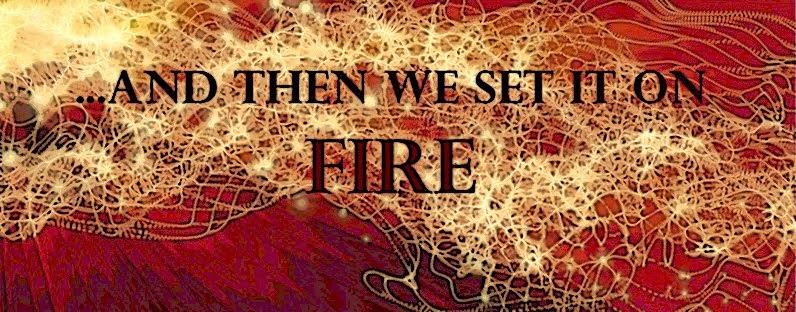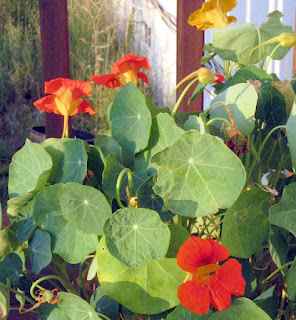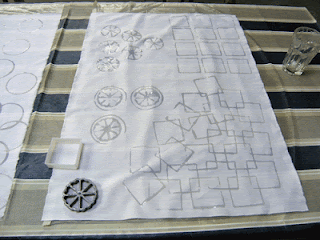Painting with Thickened Dyes
This technique has been on my "wish list" for a long time. This past May I was finally able to take a class with Hollis Chatelain at a wonderful B&B where all of us were able to spend the entire time devoted to our art without interruption. Heaven!
Although my tutorial covers primarily detailed representational painting, thickened dyes are also fabulous for free abstract painting. For purposes of this blog, I'll be working fairly small--fat quarter size or smaller.
Here's what you'll need for supplies:
 |
| This shows several choices for mixing the dyes: 2 different palettes and some small containers with red lids. |
Procion MX dyes (3 primaries and black are an absolute minimum)
Print paste - mixed (I use the ProPrint Paste SH formulation from Pro-Chem)
Palette/small containers for mixed dyes
Brushes: Synthetic nylon
(white shows the colors better than tan) in various sizes (1" and 1/4"
flat; #1, #4, #6, #8 round; angle)
Outline drawing enlarged to desired size
Reference photo
Hair dryer
Waterproof substrate on which to stretch treated fabric for painting
I use a sheet of foam core with a sheet of plastic stretched over it and taped on the back. Make sure to have NO wrinkles on the stretched surface, as these will be translated into your painting.
White or clear plastic bag (garbage bag or shopping bags are good) cut into small 3-5" pieces.
Colored pencils in colors of the major elements of your design
A sheet of clear plastic without folds or texture that is slightly larger than your fabric
Container for water for rinsing brushes
Rubber or latex/nitrile gloves
Apron
 |
| Use a Sharpie to make the outline thick and dark. |
1.
THE DRAWING should be a dark outline of the desired size for your piece of
art. Small drawings can be enlarged by 1) scan drawing into computer
and resize in a graphics or photoshop-type program, then print out using
"poster" setting in your printer. This will give you a drawing which
is spread onto several sheets that can then be taped together to form
the whole drawing. 2) use an overhead projector to project the image
onto a wall where the drawing can then be traced onto paper.
2. THE FABRIC: 100% cotton PFD pretreated with soda ash
solution and allowed to dry completely. This will be the 'canvas' for
your painting. Lay this flat to dry and stretch and pat to remove as
many wrinkles as possible. The dry fabric can be ironed, but care must
be taken when doing so to not use too high a heat. A wrinkle-free
surface is much more enjoyable to paint.
3. PRINT PASTE is the medium in which the dye powders will be
dissolved. The consistency should be a bit thinner than honey. Too
thick and it will not spread well; too thin and it will be difficult to
control the brush load of dye. Mix until all powder is absorbed, then allow to thicken for about 30 minutes before use.
Instructions
1. Tape the outline drawing to your substrate, then tape the treated and dried fabric over the drawing. Using the colored pencils, lightly trace the drawing onto the fabric. Make the lines dark enough to see, but not so dark that they'll show through the transparent layers of dye. These are reference lines for your painting, so use colors that correspond to the subject (red for red/orange/pink petals on a flower, for instance).
2. Once your design is traced, remove the drawing and tape the fabric to the substrate. Make certain to stretch the fabric as much as the tape will allow to remove those pesky wrinkles.
3. Mix your chosen colors with the print paste. Use 1/4 tsp of dye powder for about 2 Tbls of print paste mixture. Mix thoroughly.
4. Have one container of colorless print paste. This will act as your thinner for the dye colors should you want a lighter tint. Black can be mixed with colors to make darker shades.
5. Once all your colors are mixed, paint a sample of each on a scrap piece of fabric. This will allow you to know how the dyes will look on the fabric.
6. As you paint areas, use the small pieces of plastic to cover your work. It's important that the entire painting remain in a wet state in order for the dyes to 'batch'. Continue covering each area as you go. I use clear plastic for this as I like to see my work underneath to reference the colors I've used along the way.
7. Use the palette or a small plate for mixing shades for smaller areas. As you become more comfortable, it's possible to mix one color into another directly to one side of container.
Note of caution!
Dyes do not behave like traditional painting mediums such as oil, watercolor or acrylics. Painting with dyes is a bit counter-intuitive in that the first color that you lay down will be the color that appears on your final painting. So if you want a light shade or a highlight, lay that in first. Then proceed to the darker shades. Clear print paste can used to shield the white of the fabric somewhat.
Maintain a wet edge when painting larger areas. This will allow the dyes to flow without making a hard edge or line. Paint large areas in one sitting to avoid these hard edges.
This is one of my experimental pieces
 |
| The bud and green stem at the bottom were painted using thinner print paste, and they diffused more into the fabric. This might be a look to exploit, but it is difficult to control. |
|
|
This lily is one of my finished paintings and is awaiting thread painting.
Here is Hollis Chatelain with her quilt "Innocent" (aka Ernest). The size and scope of this painting in person is mind-boggling! If you look closely, you can see some of the 37 children that she's quilted into this portrait.
I'll be posting more this weekend. Blogger is giving me warning messages that there are errors and my post isn't being saved...I'm hoping that isn't the case! In the meantime, hope that you can start on a painting of your own.
















































